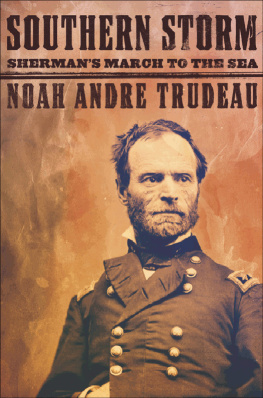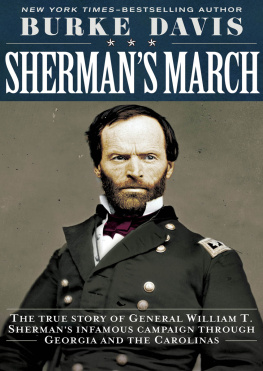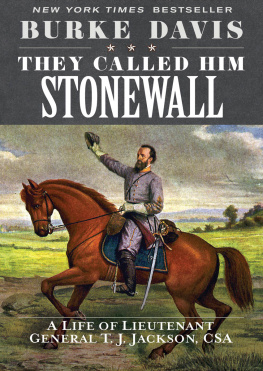O n December 21, 1864, two young menhardened for military campaigning and always ready for adventurecrossed paths in the main office of the New York Herald. Each was an experienced reporter just returned from a major campaign. John Edward Parker (Jep) Doyle had marched with Sherman from Atlanta to the sea. David Power Conyngham had been at Nashville when George H. Thomas had wrecked John B. Hoods Rebel army. Both had vivid stories to tell, stories that would soon be conveyed in the Herald s tightly packed columns for days to come. As was common practice in that day, small-market papers clipped and pasted the coverage in their own sheets, so these accounts would circulate well beyond the New York area. By then Conyngham and Doyle had returned to the front (both now with Sherman) to pick up the story and carry it through to the end.
Even before the dramatic year 1865 was over, a book would appear that offered a striking narrative of Shermans campaign across Georgia, one that was rich with detail and well supplied with lively anecdotes and character sketches. The book almost immediately became the template for all subsequent accounts of this operation, with a staying power that is impressive. One distinguished scholar, writing just after the United States marked its Civil War centennial, proclaimed it an indispensable volume for anyone studying Shermans famous campaign, and it has appeared in Sherman biographical bibliographies extending into the twenty-first century. Its author was David Power Conyngham.
Make no mistake, Conyngham did his homework. He drew from accounts penned by fellow correspondents who had been with the march, and he used his personal contacts among the armys officer corps to fill in the spaces. Save for the fact that he was not actually present for the scenes he so vividly describes as a firsthand participant, Conynghams account had sufficient truth about it that generations of later writers turned to it as the real thing.
Thus, from the very beginning, the story of Shermans March to the Sea was once removed from primary sources and subject to the dramatic sculpting of a skilled adapter. From that first subtly false step, the saga of the March to the Sea was catapulted into the realm of myth and legend.
Everyone knows Shermans March. Just to say the words is to select from a list of mental images of destructiveness, raw power, civil terror, and youthful adventure whose choice depends a great deal on where one encountered Civil War 101. Many of the memoirs of actual military participants compound the problem rather than resolve it. The most successful compress events into a narrative that is often generalized as to time or place, and which often combines several incidents into one. The most enduring memoirs of Shermans March represent a personal condensation, simplification, and intensification of what was actually experienced. It is on this ever so slightly distorted foundation of reality that the widely understood story of Shermans March rests.
In the pages that follow I have attempted to compensate for that distortion. I have relied heavily on actual diaries and period letters from participants military and civilian. Taken individually, most of these diaries are unremarkable, some downright boring. Cumulatively, however, a wealth of little details emerge that helped me sharpen the viewfinder. I quickly realized that some of the official reports, especially those for the cavalry operations on both sides, were not to be taken at face value. Throughout my treatment of these movements and actions, I relied on available diaries and letters to keep things honest, to which I added healthy doses of what I hoped was common sense.
Sherman, too, despite an outspokenness that often passes for frankness, needed to be handled with care. Here, fortunately, I had the invaluable journals of Henry Hitchcock, George Nichols, and others on the Generals staff to balance things. The fine selection of contemporary dispatches written in the field that are found in the official records further helped me determine what Sherman knew and when he knew it. The standard story has the General fixed on his objective from the moment his legions departed Atlanta; in reality, he kept his options open until he finally had to commit himself in early December. Instead of an exercise of predestination, I approached this as any other military campaign, subject to all the uncertainties and improvisations that such implies.
One source you will see indirectly acknowledged in the bibliography is the network of narrative historical markers erected over the years along the various routes of Shermans operation. Graced by texts and research provided by two able Georgia historiansWilbur G. Kurtz Sr. and Allen P. Julianthey contain countless little details regarding roads taken or residences visited. Sadly, many were missing when I passed through, others had been relocated, but the texts for all have been preserved. Even as I write this, the state of Georgia is constructing a new series of markers as part of a heritage trail. From the preliminary materials I have seen, it promises to be a significant addition to our understanding of the March to the Sea.
A part of the saga that interested me very much was the weather story. The generalized narratives I encountered seemed to suggest sunshine and blue skies for the entire journey. Yet daily logs kept by participants told a very different story. In the process of trying to make sense out of those entries, I found that even the most mundane diary of Shermans March usually had some things to say about the weather on a given day. When I indexed these together and compiled them chronologically, I realized that on any given twenty-four-hour period I had a dozen or more weather observations. To be sure, the data were subjective (cold, warm, cool, or hot for temperature, for instance), but when they were taken as a group, a consensus of weather conditions emerged and became part of my story. Based on the information in those diaries, I calculated the temperature ranges you will see for each day of the march.
A fair number of diary entries for soldiers taking part in this campaign are best summarized with the phrase: Nothing of interest to report. Yet when one takes into account the totality of the fifty or so diaries with entries for a particular day, I never found that to be the case. I was continually amazed at the rich variety of small, personal stories that emerged. It is part of my hope that by following the march from day to day, and fitting these stories into the fabric of the whole, a more truthful narrative of events will emerge. I hope too that it is a more compelling one.









